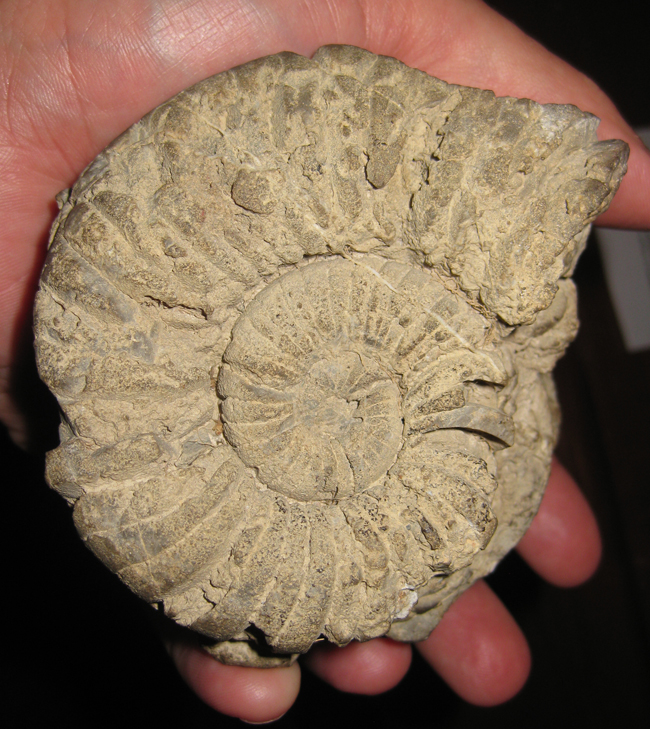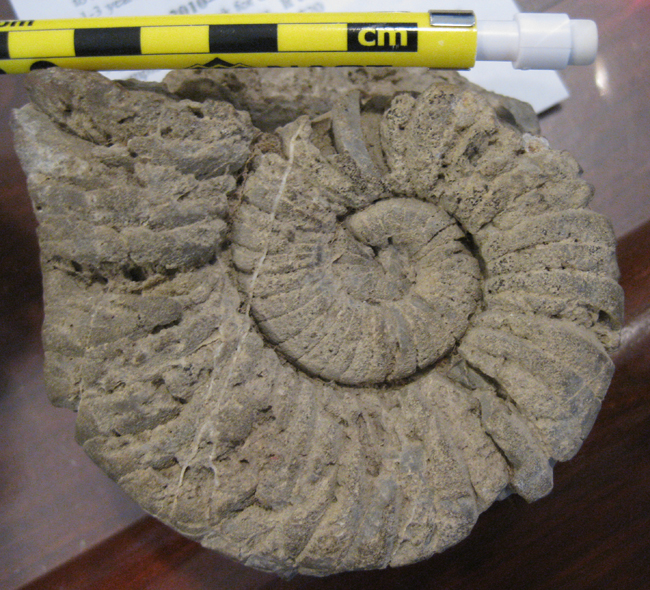After our jaunt down in Staunton and Waynesboro, Lily and I headed north through the Shenandoah Valley, and tried a new winery. This has been a thing we’ve been doing lately – visiting various Virginia wineries and thinking about their geology while sampling their wares. This time, we went to Cave Ridge Vineyard, which is located just east of Little North Mountain, on Cave Ridge, a topographic high held up by the dolomitic Beekmantown Formation. When they were digging the foundations for the tasting room building, they uncovered lots of fossils, one of which stays in the tasting room for guests to view:

That’s a coiled nautiloid (note the smooth, gently curved septa that subdivide the shell into chambers). Unfortunately, VirginiaWine.org incorrectly identifies this as an ammonite, which shows they need a geological consultant familiar with the ranges of local fossil species. (Ammonites are limited to the Mesozoic, and these rocks are early Paleozoic in age.)
Here’s a second photo, sans flash, and with the scale pencil instead of fingers for scale:

Here is a geologic map of the area, modified from Young and Rader (1974):


Because the Beekmantown is dolomitic, it weathers more slowly than do the limestones which are stratigraphically above (southeast) and below it (northwest). There were big chunks of holey dolostone ringing the trees in the Cave Ridge Vineyard parking lot, and if you visit, you can search them for fossils. I didn’t find any myself.
This lovely beast graces the label of one of their red wines, the Fossil Hill reserve, a blend of Cabernet Franc, Chambourcin, and Petite Verdot. While we liked that wine, the one that really impressed us was Cave Ridge’s Traminette. We got a bottle of that, and enjoyed a glass in the sun, with our baby crawling around and being very inquisitive and cute. The traminette wasn’t named for a fossil, but that’s okay. It was delicious and had a lovely floral aroma.
My visit to Cave Ridge was “field work” for a new Smithsonian Associates class that I will be running this fall on the geology of Virginia wine country. While the geological tie-ins of Cave Ridge are superb, I think its location is probably a bit far for a one-day tour that originates (and must return to) Washington, DC.
Map cited:
Young, R.S., and Rader, E.K., 1974, Geology of the Woodstock, Wolf Gap, Conicville and Edinburg quadrangles, Virginia: Virginia Division of Mineral Resources, Report of Investigations 35, scale 1:24,000

You are correct about this fossil being a nautiloid, If you are correct about it being Ordovician then it is very rare, I have been collecting for over 45 years and I have only found one Ordovician coiled nautiloid in Kentucky. Straight ones are very common but coiled ones are very rare.